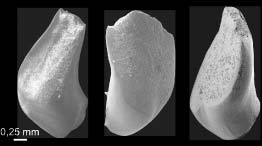Bighead Carp: From 5 to 150 centimeters in 37 million years

Since 2008, an international research team led by Prof. Dr. Madelaine Böhme from the Senckenberg Center for Human Evolution and Palaeoenvironment (HEP) of the University of Tübingen has been studying prehistoric ecosystems and fossils in Vietnam.
In the course of this research the scientists discovered approximately 37 million-year-old sediments from Lake RhinChua, dating to the late Eocene. These freshwater sediments contained a wealth of fossilized animals and plants; hence, Lake RhinChua is also referred to as the “Asian Messel” by the researchers.
During their studies the team discovered teeth belonging to an entirely new genus and species of fish: The oldest known bighead carp, Planktophaga minuta, is a representative of the “East Asian group of Leuciscinae.”
With a length of ca. 5 centimeters it is the smallest fossil representative of this East Asian group, and a mere dwarf compared to its modern living relatives. Modern bighead carp are among the largest members of the carp family. They grow up to a length of 1.5 meters and can weigh in at 50 kilograms.
Planktophaga minuta and its relatives
Besides Planktophaga minuta (which translates to small plankton eater), an additional six species of carp have been discovered in Lake RhinChua. All of them have living relatives that are still found today in China’s Pearl and Yangtze River system. This is proof that the roots of the modern freshwater fish fauna in Southeast Asia reach far into the past.
Bighead carp in exile
Originally, the bighead carp was native to the larger rivers and stagnant water bodies of southern China. During the 1960s, bighead carp were introduced in Europe, including Germany, as a means to control aquatic plants. Only later did researchers discover that the bighead carp failed to “fulfill this task,” since they mainly feed on animal plankton. In Europe, introduced bighead carp can be found in ponds, lakes and occasionally in streams and rivers.
Publication
Böhme, M. et al.; Na Duong (northern Vietnam) – an exceptional window into Eocene ecosystems from Southeast Asia, ZittelianaA 53, 120 A 5 (2014).
Online: http://www.palmuc.de/bspg/images/pdf/10_boehme.pdf
Contact
Prof. Dr. Madeleine Böhme
Department of Geosciences
Senckenberg Center for Human Evolution and Palaeoenvironment
(currently away on expedition)
madelaine.boehme@senckenberg.de
Press Offices
Press Office
Senckenberg Gesellschaft für Naturforschung
Ilona Bröhl
Phone 069- 7542 1444
pressestelle@senckenberg.de
University of Tübingen
University Communications
Antje Karbe
Phone 07071 – 29-76789
antje.karbe@uni-tuebingen.de
Media Contact
All latest news from the category: Earth Sciences
Earth Sciences (also referred to as Geosciences), which deals with basic issues surrounding our planet, plays a vital role in the area of energy and raw materials supply.
Earth Sciences comprises subjects such as geology, geography, geological informatics, paleontology, mineralogy, petrography, crystallography, geophysics, geodesy, glaciology, cartography, photogrammetry, meteorology and seismology, early-warning systems, earthquake research and polar research.
Newest articles

High-energy-density aqueous battery based on halogen multi-electron transfer
Traditional non-aqueous lithium-ion batteries have a high energy density, but their safety is compromised due to the flammable organic electrolytes they utilize. Aqueous batteries use water as the solvent for…

First-ever combined heart pump and pig kidney transplant
…gives new hope to patient with terminal illness. Surgeons at NYU Langone Health performed the first-ever combined mechanical heart pump and gene-edited pig kidney transplant surgery in a 54-year-old woman…

Biophysics: Testing how well biomarkers work
LMU researchers have developed a method to determine how reliably target proteins can be labeled using super-resolution fluorescence microscopy. Modern microscopy techniques make it possible to examine the inner workings…





















